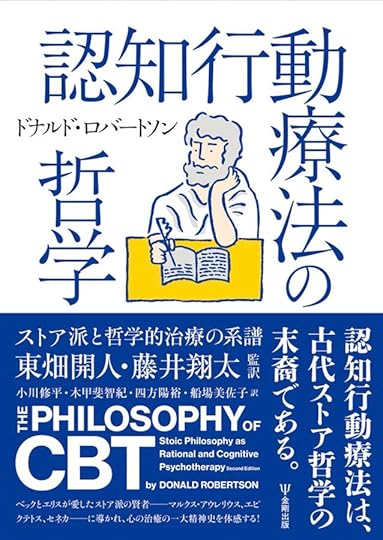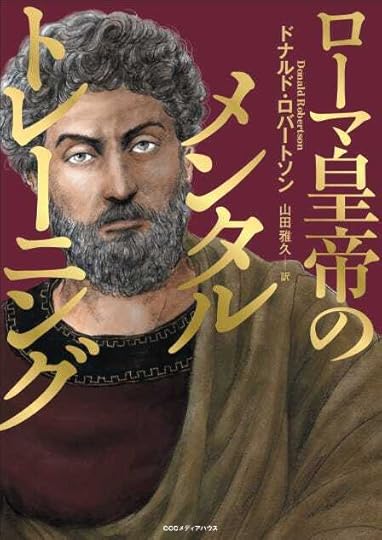Foreword to the Japanese Edition of The Philosophy of Cognitive-Behavioural Therapy
It’s my pleasure to share with you, below, the foreword I wrote for the 2022 Japanese edition of my book The Philosophy of Cognitive-Behavioural Therapy, which discusses the links between Stoic philosophy, Cognitive Therapy, Greek Skepticism, and Asian thought, such as Hinduism and Buddhism.
 Foreword
ForewordIt’s a great pleasure and honor for me to write this foreword to the Japanese translation of The Philosophy of Cognitive-Behavioural Therapy. This was the first book on Stoicism written by me. The original English edition was published in 2010 by Karnac, and a 2nd revised edition by Routledge in 2020. My subsequent book, How to Think Like a Roman Emperor: The Stoic Philosophy of Marcus Aurelius (2019), is also being translated into Japanese. Indeed, the philosophy has seen a huge resurgence in popularity in English-speaking countries, over recent decades, and increasingly in several non English-speaking parts of Europe.
Cognitive therapy gives us a way of understanding both the cause and cure of emotional disturbance, which reflects the values and concerns of modern society.
Until recently relatively few books on Stoicism have been available in Japanese. However, I understand that during the last decade, more ancient and modern literature on Stoicism has been published in Japan. Why is this ancient Western philosophy, and the modern psychotherapy inspired by it, so appealing to many of us today across both eastern and western cultures? Cognitive therapy is based on an “information-processing” model of emotion and it’s arguably no surprise that its popularity coincides with what is sometimes called the “Information Age”. Since the middle of the 20th century, we have become increasingly accustomed to consuming information. We’re bombarded with it like never before, through digital technology and social media. As a result, we have learned to be more wary about the effects of misinformation on our own state of mind and the minds of others. Cognitive therapy therefore gives us a way of understanding both the cause and cure of emotional disturbance, which reflects the values and concerns of modern society.
Nevertheless, the cognitive revolution in psychology and psychotherapy marked a return to the very ancient insight that our emotions are cognitive in nature – feelings are closely tied up with thinking. In the West this cognitive model of emotion can be traced back to the Stoics and before them to Socrates. However, there’s long been interest in the apparent parallels between ancient western and eastern philosophies. Some of the common themes shared between these two traditions could even be due to the historical exchange of ideas across cultures. There are stories of Greek and Roman philosophers from Pythagoras, in the 6th century BCE, to his follower, the neopythagorean Apollonius of Tyana, in the 1st century CE, for instance, having journeyed to India and conversed with the gymnosophoi or “naked wise men”.
Stoicism: Philosophy as a Way of Life is a reader-supported publication. To receive new posts and support my work, consider becoming a free or paid subscriber.
The “Naked Wise Men” of IndiaAccording to one source, it was rumoured that even Socrates had the opportunity, in the 5th century BCE, to discuss philosophy with an Indian visiting Athens:
For a man of [the Indian] people met Socrates in Athens and asked him what his philosophy was about; and when he said that he was investigating human life, the Indian laughed at him, saying that no one could understand human affairs if he ignored the divine. (Eusebius, 4.13)
In the 4th century BCE, the Macedonian king Alexander the Great, conquered Persia and, pushing relentlessly east, ultimately invaded the northwest of India. Alexander took several philosophers with him as part of his entourage, perhaps most notably Pyrrho of Elis, later the founder of a philosophical school known as Greek Skepticism. Some people believe that Pyrrho’s Skeptic philosophy may have been influenced by early Indian Buddhist teachings. Likewise, Greek philosophy may have had some influence upon eastern thought, particularly the teachings of Nāgārjuna, the founder of the Madhyamika school of Buddhist philosophy.
However, there’s no historical evidence of direct communication between the philosophers of the Stoic School and eastern sages. Indeed, in the centuries following the death of Alexander, and the collapse of the Seleucid Empire that followed his rule in Persia, direct contact between the west and east became increasingly difficult due to the growing power of the Parthians. The Parthian Empire came to control the important silk trade routes between China and the Roman Empire. Nevertheless, there is some evidence that envoys from a Roman emperor called “Antoninus”, the dynastic name used in official documents for Marcus Aurelius, made their way to the court of Emperor Huan, in Luoyang. As far as we know, nothing of significance came of this contact, though, and perhaps a valuable opportunity was missed for a historic exchange of ideas between the court of the Stoic Roman emperor and the intellectuals of Han dynasty China.
Greek SkepticismNevertheless, early contact between Indian gymnosophists and earlier Greek philosophers, such as the Skeptics and Pythagoreans, may in turn have influenced the Stoics. In his The Shape of Ancient Thought (2002), Thomas McEvilley, Distinguished Lecturer in Art History at Rice University, in the USA, provided a detailed analysis of the relationship between ancient Eastern and Western thought. McEvilley describes the many striking parallels between Pyrrho’s Skepticism and Buddhist philosophy but he goes beyond this to examine possible links between eastern thought and other branches of Greek philosophy, including Stoicism. He concluded that overall, despite some notable differences, Stoicism resembled a Western version of Brahmanical Hinduism.
For example, McEvilley sees obvious parallels between the ancient Hindu ethical doctrine of karma yoga and the Stoic discipline of action. The Stoics teach that our actions should be brought into alignment with Nature, by which they meant that we should not struggle against or complain about our fate.
Stoicism and Zen BuddhismThe action of a harmonized [Stoic] sage is precisely like the action of the accomplished karma yogin as described in the Bhagavad Gita, action not performed for personal ends or with attachment to any particular goal, but simply out of cooperation with the facts of cosmic harmony; one relates always to the infinite Zeus or Krishna while performing one’s finite actions.
John Sellars, a Reader in Philosophy at Royal Holloway, University of London, and a leading contemporary expert on Stoicism, has also noted parallels between related concepts in Stoic ethics and certain aspects of Japanese Zen Buddhism. For example, in De Finibus, Cicero, provides a famous explanation of the Stoic philosophy of action, which centers on the analogy with archery or spearmanship:
Take the case of one whose task it is to shoot a spear or arrow straight at some target. One’s ultimate aim is to do all in one’s power to shoot straight, and the same applies with our ultimate goal. In this kind of example, it is to shoot straight that one must do all one can; none the less, it is to do all one can to accomplish the task that is really the ultimate aim. It is just the same with what we call the supreme good in life. To actually hit the target is, as we say, to be selected but not sought.
Cicero portrays the Stoic Cato the Younger giving this explanation, although Sellars notes that it can be traced back at least as far as the Stoic scholarch Antipater of Tarsus, in the 2nd century BCE.
Sellars finds similarities between this Stoic account of action and the Japanese philosophy described in Eugen Herrigel’s book Zen in the Art of Archery (1953). The Stoics taught that the archer should seek to aim well even though it is ultimately not up to him whether or not he hits the target. He should view both hitting and missing with equanimity. Herrigel likewise learned from his Zen master that what happened to the arrow, once it had flown the bow, was “a matter of indifference”. The real goal is internal rather than external – it is the goal of spiritual, or psychological, transformation. What matters is how one acts rather than merely the outcome of the action. As Sellars puts it, “What the Zen art of archery and the Stoic art of living share is a seemingly paradoxical indifference to whether one is successful or not.”
ConclusionIt’s my hope that this translation of The Philosophy of Cognitive-Behavioural Therapy, may lead to additional fruitful comparisons between Greek philosophy, particularly Stoicism, and eastern thought, including the teachings of Japanese philosophy and religion. The links made in this text between ancient Stoicism and modern cognitive-behavioral therapy will, I think, make it easier to identify these parallels. Approaching the subject from this interdisciplinary perspective also helps to make apparent the enduring practical relevance of ancient thought for the everyday problems of modern life, such as coping with anxiety and depression, and cultivating emotional resilience. Ancient thought, both eastern and western, still has much to teach us in this regard.
ReferencesMcEvilley, Thomas (2002). The Shape of Ancient Thought: Comparative Studies in Greek and Indian Philosophies. Alsworth: New York.
The Japanese translation of my book The Philosophy of Cognitive-Behavioural Therapy was published in 2022 by Kongo Shuppan. Shota Fuji, the translator, and his colleagues, worked very hard to create the book, under the supervision of Dr. Kaito Towhata. Another of my books, How to Think Like a Roman Emperor, is also available in Japanese, from CCC Media House.

Thank you for reading Stoicism: Philosophy as a Way of Life. This post is public so feel free to share it.



